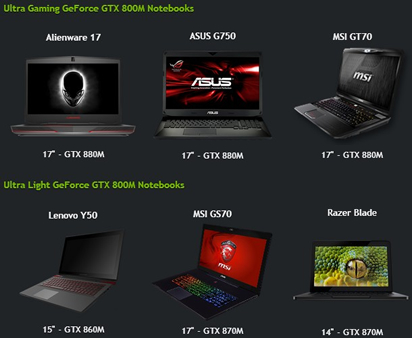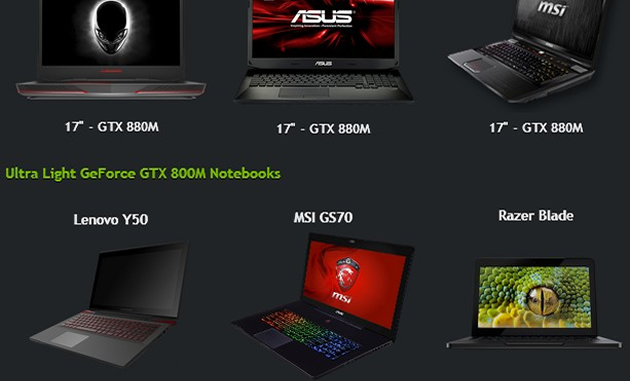Gaming notebooks have progressed by leaps and bounds in recent years, edging ever closer to performance and feature parity with desktops. PC graphics chip maker Nvidia hopes to narrow that gap even further with its announcement of new GeForce GTX notebook graphics processors (GPUs) that deliver the same features and benefits as its latest desktop GPUs.
 Faster, lighter notebooks
Faster, lighter notebooks
Nvidia claims new GeForce GTX 800M GPUs are up to 60 percent faster than previous-generation mobile GPUs. The new processors also boast improved power efficiency, and give notebook gamers access Nvidia’s desktop features GPU Boost 2.0, GeForce ShadowPlay, and GameStream.
Several notebook manufacturers this week announced new models with GeForce GTX 800M graphics housed in Nvidia’s Kepler and Maxwell GPUs — including Alienware, Asus, Lenovo, MSI, and Razer.
New Battery Boost features
GeForce GTX 800M also introduces Battery Boost, a new feature that Nvidia says can double the amount of game time on a single battery charge, while still delivering great GTX graphics at playable frame rates. That means that notebook gamers can get up to twice as much game time when unplugged, while still getting a 30+ FPS experience.
To achieve this, Nvidia says that Battery Boost adjusts the power needs of the GPU, CPU, and memory automatically to deliver a user-targeted frame rate (30 FPS by default). If you want faster frame rates or longer battery time, you can adjust Battery Boost using a simple slider in the GeForce Experience dashboard application.
Nvidia’s GeForce Experience dashboard also now includes a per-game Adjustable Optimal Playable Setting function for Battery and AC gaming modes, which allows you to further stretch battery life on GeForce Experience supported games.
On desktop PCs, GeForce Experience also streams games to Nvidia SHIELD, and lets you capture in-game action with GeForce ShadowPlay Beta, a built-in, free app that can record clips of your most exciting game play for other gamers to watch on Twitch.tv. Nvidia says you’ll be able to use ShadowPlay on notebooks soon.
For examples and charts of GeForce GTX 800M’s promised performance boosts, check out Nvidia’s GeForce blog post.





